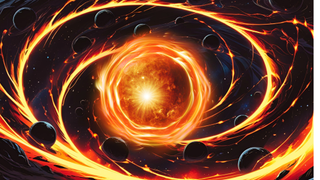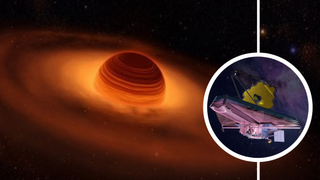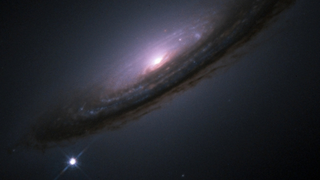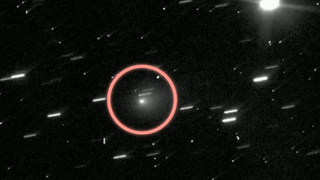Robert Lea is a science journalist in the U.K. whose articles have been published in Physics World, New Scientist, Astronomy Magazine, All About Space, Newsweek and ZME Science. He also writes about science communication for Elsevier and the European Journal of Physics. Rob holds a bachelor of science degree in physics and astronomy from the U.K.’s Open University. Follow him on Twitter @sciencef1rst.
Latest articles by Robert Lea

Black holes that transform matter into dark energy could solve 'cosmic hiccups' mystery
By Robert Lea published
If black holes are actually droplets of dark energy that convert stellar matter into this mysterious and dominant force, many "cosmic hiccups" could soon be cured.

1st-of-its-kind quadruple star system could reveal secrets of 'failed star' brown dwarfs
By Robert Lea published
A rare quadruple star system with two brown dwarfs orbiting two red dwarf stars could help shed light on how these "failed stars" change with age.

Astronomers discover brightest ever fast radio burst: 'This marks the beginning of a new era'
By Robert Lea published
Astronomers have spotted what could be the brightest Fast Radio Burst explosion of radiation ever, tracing it back to source and further investigating with the James Webb Space Telescope.

Astronomers discover strange new type of supernova: 'This is the first time we have seen a star that was essentially stripped to the bone'
By Robert Lea published
A weird and extremely violent new type of supernova in which a massive star was "stripped to the bone," offers a rare glimpse of the interior of a massive star prior to its death.

If aliens explore space like humans do, NASA scientists know where to look for their signals
By Robert Lea published
Studying the signals that humanity beams through the solar system has allowed a team of NASA researchers to pinpoint where and when astronomers should hunt for alien technosignatures.

Astronomers trace massive cosmic explosion back 12 billion years. 'This is the most distant event where we can directly see light escaping from around stars'
By Robert Lea published
Astronomers used the Einstein Probe to track a powerful blast of X-rays back to its source in the early universe.

Vera C. Rubin Observatory: Everything you need to know
By Robert Lea last updated
The Vera C. Rubin Observatory has begun the 10-year-long Legacy Survey of Space and Time to investigate mysteries like the nature of dark energy.

Did 'primordial' black holes born right after the Big Bang help our universe's 1st stars form?
By Robert Lea published
New research suggests that primordial black holes could have played an important role in the formation of the universe's first stars, but did they help or hinder?

Is life widespread throughout the cosmos? Complex organic molecules found in planet-birthing disk
By Robert Lea published
Complex organic molecules that could be the precursors to the building blocks of life as we know it have been discovered in a disk of gas and dust swirling around an infant star.

Nearby super-Earth K2-18 b may be a water-rich ocean planet: 'This has certainly increased the chances of habitability'
By Robert Lea published
The search for life beyond the solar system is heating up. Though biosignatures around super-Earth K2-18b remain unconfirmed, the JWST has found the planet could be a water-rich ocean world.

James Webb Space Telescope finds giant, lonely exoplanets can build their own planetary friends without a parent star
By Robert Lea published
Using the James Webb Space Telescope, astronomers have made the shock discovery that giant rogue exoplanets can grow their own planetary systems without needing a parent star.

Hubble Space Telescope spots rogue planet with a little help from Einstein: 'It was a lucky break'
By Robert Lea published
"This discovery was partly serendipity! But, we believe there are many more such opportunities hidden in Hubble data."

Biggest cosmic explosion on record since the Big Bang is revealing the secrets of gamma-ray bursts
By Robert Lea published
The BOAT is the ruler of all gamma-ray bursts, releasing as much energy in seconds as the sun will in 10 billion years — and it could be revealing the secrets of these extreme cosmic blasts.

James Webb Space Telescope finds black holes that waited patiently before devouring stars in dusty galaxies
By Robert Lea published
Using the James Webb Space Telescope, astronomers hunted supermassive black holes devouring stars in dusty galaxies — but laying in wait for their stellar victims.

Cosmic rays gave the Fantastic Four their incredible powers — but what do they really do?
By Robert Lea published
It's 1961, and four intrepid cosmic explorers journey to space under the leadership of Reed Richards, where they encounter cosmic rays that change them forever. But what are cosmic rays?

Largest-ever supernova catalog ever provides further evidence dark energy is weakening
By Robert Lea published
A catalog of over 2,000 exploding white dwarf vampire stars, the largest ever gathered, has provided further evidence that dark energy is weakening.

Interstellar invader Comet 3I/ATLAS is packed with water ice that could be older than Earth
By Robert Lea published
Scientists have examined the interstellar invader 3I/ATLAS, finding evidence that it is packed with water that could be older than the solar system.

This star escaped a supermassive black hole's violent grips — then returned for round 2
By Robert Lea published
A death-defying star survived destruction by a ravenous supermassive black hole in a tidal disruption event, and came back to let the cosmic titan take another bite!

This 200-light-year-wide structure could be feeding our galaxy's center: 'No one had any idea this cloud existed'
By Robert Lea published
Astronomers have discovered a 200-light-year-wide Giant Molecular Cloud dubbed the Midpoint cloud that seems to be feeding star-building material to the heart of the Milky Way.

Hubble spots interstellar invader Comet 3I/ATLAS for the first time
By Robert Lea published
The long-serving space telescope saw the third interloper to enter the solar system from beyond its limits late on Monday morning (July 21).

These 3 popular skywatching star clusters may be branches of the same family tree
By Robert Lea published
The Orion Nebula, the Pleiades and the Hyades open clusters could represent the different phases of star clusters: baby, adolescent and elderly.

Astronomers crack 1,000-year-old Betelgeuse mystery with 1st-ever sighting of secret companion (photo, video)
By Robert Lea published
Astronomers have finally imaged the long theorized companion star of Betelgeuse, solving a mystery regarding its dimming that has persisted for millennia.

What are these strange swirls around an infant star? 'We may be watching a planet come into existence in real time'
By Robert Lea published
Astronomers have discovered a baby exoplanet "spiral architect" carving complex swirls into a disk of gas and dust around the young star HD 135344B.

NASA's Roman Space Telescope could discover 100,000 new cosmic explosions: 'We're definitely expecting the unexpected'
By Robert Lea published
Supernovas, kilonovas, gamma-ray bursts... oh my! The Nancy Grace Roman Space Telescope will uncover 100,000 of these explosions and many more powerful and violent cosmic events.
Breaking space news, the latest updates on rocket launches, skywatching events and more!


